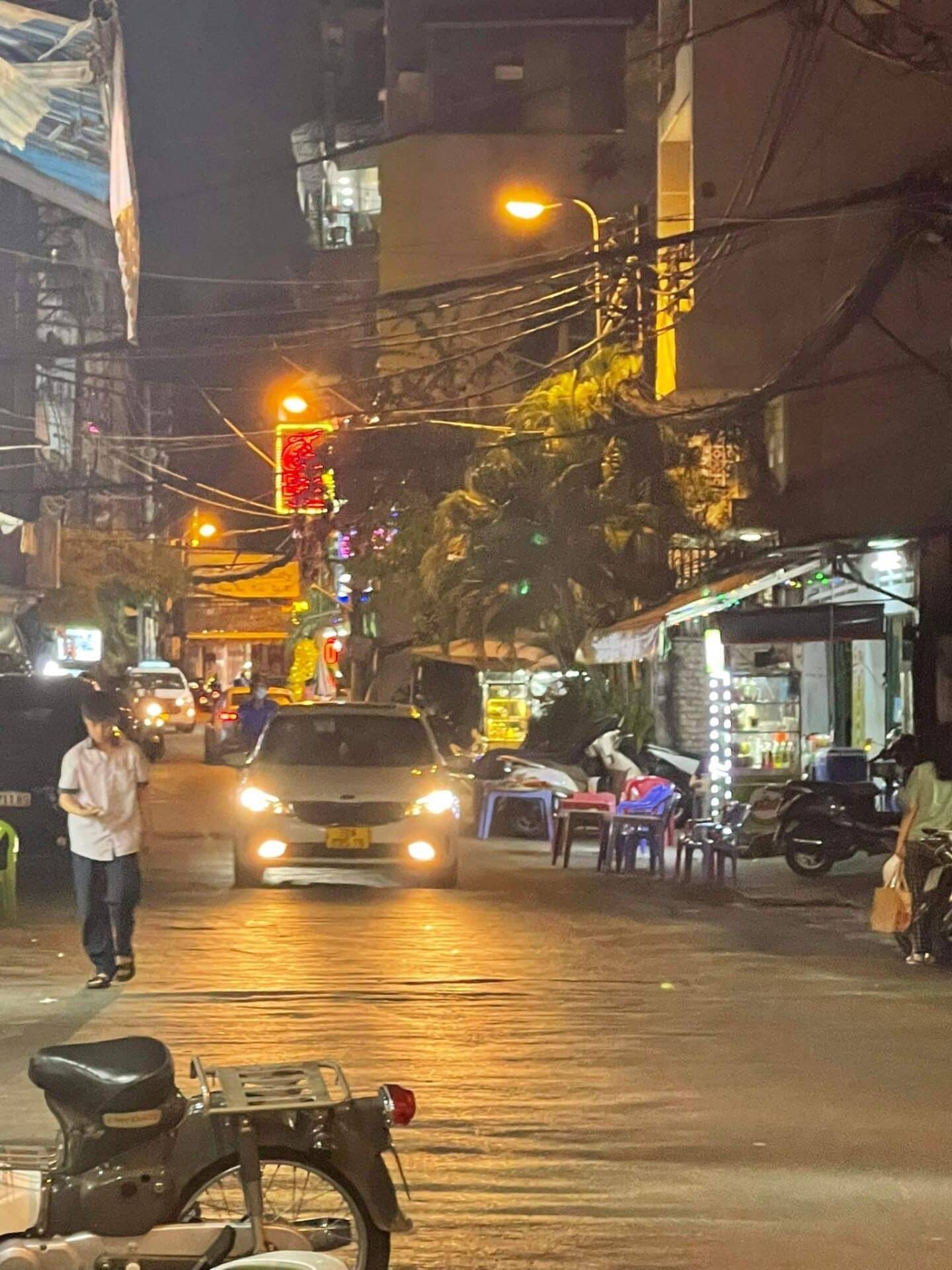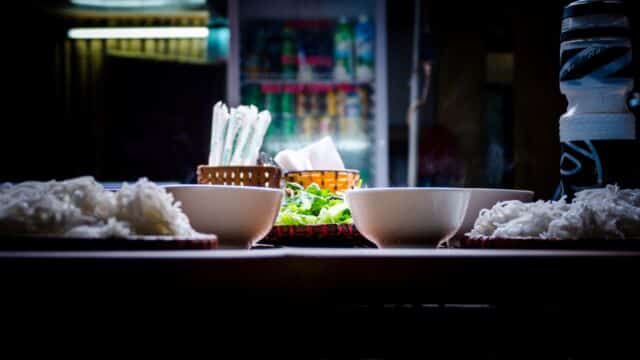In the Heart of HCMC, Seeking One Place That’s Permanent
Photo: Viên An
An intersection of alleys in Ho Chi Minh City, referred to as ‘256b’ | 2,000 words
Translated from Vietnamese by Ba Thùy
‘Each patient can only be looked after by one relative. Please abide by the prevention methods while looking after the patients’. The blaring speakers jolted me awake, my forehead thudding against the glass of the bus that never ceased to rock. My stomach growled, but it would have to wait a few more minutes to be filled, as the roadside eateries in this central district are all too costly for me. My money can only afford food from particular places in the city center. These speakers from Từ Dũ Hospital brought to mind the early days of the pandemic: from 2020, whenever there was news of a new variant, this recording would be broadcasted, as if out of a belief that it would protect everyone’s serenity.
To hear this recording meant I was close to my rented apartment. I live in an alley frequented by migrants close to Từ Dũ Hospital, from which ring out the cries of so many newborn babies who make their entry into life as residents of Ho Chi Minh City. I wasn’t born a resident of this city. Hailing from a small village all the way in Vũng Tàu and eager for a stable job in a city with more than nine million people already, I longed to live in a space comfortable for those far from home.
This alley neighborhood lies adjacent to Nguyễn Cư Trinh and Nguyễn Trãi Roads. Were you to venture deep inside, you’d find it, like other alleys of Ho Chi Minh City, to be labyrinthine and myriad. House addresses just keep piling on top of one another — ‘256b/5b/5/7’ — like numbers randomly jumping towards infinity.
I often picture a neighborhood like mine as a fortress. On its periphery are the luxurious stores of District 1 that all but form walls and allow no pathway through. But here in the center, the scenery changes: houses of multiple shapes from rectangles to even triangles, due to being built on small irregular plots of land; new apartments piling on top of old ones; arbitrarily-numbered alleys that meet at intersections wide enough for kids to have played football during the lockdown period, for flea markets to gather in the morning, and for densely-packed evening stores to serve construction workers, students and other migrants who have to go and make a living in the heart of the expensive District 1, before returning back here.
The place that I sought at the end of my classes and work shifts was one such peculiar intersection of alleys, tucked away in a system collectively numbered as alley 256b.
It was 9:30 p.m. I passed by a food cabinet and realized the dishes I most liked were sold out. Suddenly, Aunt Xuân, the food vendor, called for me and brought out a plate with fried pork belly and a chả trứng omelette — my favorites at her eatery.

‘I didn’t see you come back at 8 pm, so I saved you a portion.’
I thanked her and sat down amidst the rustling conversations in the store. Aunt Xuân’s place was like most typical streetside tiệm cơm rice eateries in Vietnam. There were some sets of plastic tables and stools, then a three-shelved, interior-lit glass cabinet boasting all sorts of dishes that might be present at a Vietnamese meal table: braised fish, canh chua sour soup with snakehead fish, fried meat, fried eggs, bitter melon soup, caramelized pork, et cetera. These dishes are so simple and so familiar to our taste buds that we can eat them day to day, month to month without boredom. We eat them either to console our hankering for the meals cooked by our mothers or to console ourselves, because apart from consuming these familiar dishes, we cannot afford to eat regularly in any of the more ‘exotic’ restaurants in a city that claims to have everything from every region of the country, if not the world.
As I ate my dinner, I tuned in to curt exchanges from migrants like me:
‘I can’t go back home this year. I’m out of money’.
‘If only I could be at home right now. This season down west, I’d be dragging a boombox and doing karaoke round the neighborhood!’
‘Ever since the pandemic began, I still haven’t got a ticket home. It’s been three years!’
Indeed, three years after the pandemic began, the economy is still not back to normal in Ho Chi Minh City. After the lockdowns ended, it turned out that many workers had moved away. During the subsequent international supply chain problems and inflation, lots of individual firms, construction sites, and factories have gone bankrupt, been downsized, or cut their employees’ salaries. The cost of living has risen. Even as news headlines continue to report Vietnam posting high GDP growth figures, life for the working people and migrants of this area I live in, always hard, has gotten harder recently. Aunt Xuân has had to change her opening hours from between 7 p.m. and 2 a.m.—which was to focus on catering to construction workers returning at night—to between 11 a.m. and 2 a.m., just so she can recoup the cost of opening each day. Here, the way folks sell goods is they borrow money by the day, purchase things to sell, then repay in accordance with the deadline.
‘There’ve been fewer customers these days, but I’ve got to keep trying to sell here,’ Aunt Xuân said.
‘Right,’ I replied.
‘It’s not that I can’t sell anywhere else. It’s that there are still so many people who’ve eaten at mine for thirty years now. They’re like family, I can’t leave them behind.’
I studied her and realized that for the past few years, I have also lived by her rice. Not knowing how to fill in the silence of the conversation, I looked up in search of Aunt Tâm the soy milk vendor, yet nobody was there. Aunt Xuân caught me doing so and said:
‘She quit, dear.’
Seeing my lack of response, she continued:
‘Her daughter-in-law gave birth, so she had to go back to the countryside to take care of her grandchild. That’s how it is down there. But when she got back there, she said she’s old now, and her children feared her health would be on the decline in the pandemic so she’s probably not coming back to the city anymore’.

So the unique glass of milk that I mixed out of mung beans, soy and peanut butter by visiting Aunt Tâm’s cart a few days ago was the last one.
In front of Aunt Xuân’s eatery was always Aunt Tâm’s soy milk cart. It was a nighttime landmark for workers and students who still wanted drinks that were believed to be healthy like soy milk, mung bean milk and kumquat tea. My local friends and I dubbed her ‘the queen of the gays’ because for some unknown reason, all the gay people in the neighborhood would always come to her stall every evening to drink and chat. My gay friend, who used to drop by and drink soy milk every day too, pointed out to me who belonged to their world, which turned out to be almost everybody in front of me. My friend said, ‘All the gays recognize one another. It’s cool that Aunt Tâm can do this even though she’s straight’.
‘Aunt Tâm stood at this same spot with me for nearly thirty years,’ Aunt Xuân said. ‘Back then, the place you’re renting now was still a one-story house in the middle of a big garden.’
I peeked at the patch of land that she mentioned. Now upon that big garden was the multi-story apartment block in which I was renting a small room. Aunt Xuân’s eyes scanned through all the rows of houses that were growing around this neighborhood, as if she was recalling the gardens and one-story houses that stood here three decades ago. All these new houses were built mostly by the same workers who had come to eat at her store.
I stood up, only to realize I had no more cash in my wallet. Aunt Xuân saw that and smiled:
‘Just leave it be, dear. You can pay me when you come by tomorrow.’
The last time I was this favored was when I went to get medicine for a friend of mine, who was having a stomachache that day. When I opened my wallet to pay, there was no cash at all. The pharmacist immediately said: ‘You’re a student, eh? I’ll let you owe me then. You can pay me when your mom sends you money next month’. Since then, I sometimes had a bad, awkward habit of paying back only after I got money the following month. I later found out all students were favored like that.
Aunt Xuân continued to open up: ‘You know, my customers are all migrants who have to come to this city to live. They’re all builders, they’ve built countless houses from the tiniest to the most giant ones like villas for celebrities or some other folks. But every year in their lives, they would promise their family that they’d come back to the countryside and build a house next year. They’ve promised that time and time again for thirtyish years, and they still can’t build a house of their own yet. I don’t know what it’s going to be like.
‘We just have to keep trying, dear. Heaven makes both elephants and the grass they eat. Maybe next year, you and I will win the lottery, or you’ll do so much better that you can build a house and they’ll be able to build a house too. If they manage to build a house down in the countryside, they’ll surely give me a call and tell me all about it, dear. Then, I’ll be glad ‘cos I know they’ve got their own house’.
With this conversation, Aunt Xuân the food vendor appeared to officially put me on the list of cherished customers that also included construction workers who had worked all around this city for the past thirty years. I didn’t know if I should be happy or sad. I was happy that I could get close to her, because as you know, getting close to a food vendor who had cooked for thirty years and had always been frequented by customers would benefit someone far from home like me. Still, I was sad. What if I was also a person who couldn’t build a house in the years to come?
Light had receded from the scene before my eyes. The eatery that sold noodles, fried rice flour cakes and fried fish balls had closed earlier than usual, also because there were fewer workers coming by.
The smell of incense had now wafted into the air, and I knew it was time for Aunt Xuân to close the eatery. The owner of the house whose ground floor Aunt Xuân rented had come downstairs to light incense on his family altar. Many families rent out the ground floor that doubles as the living room where the altar of their familial ancestors is placed. The homeowner lets others use this space to open eateries, hair salons or any other kinds of store. The sacred place containing a house’s ancestors overlays a public space, with regular patrons, strangers coming to buy and sell, or visitors dropping by. It’s as if both the living and the dead, both city residents and migrants are symbiotic in these narrow spaces.
Night will pass, and morning will return to the little house that Aunt Xuân rents immediately behind her stall every evening. As the day begins, I will pass by the house and hear the owners urge their children to school. Every fold of the matinal life in that house will seem uninterrupted, the eyes of the dead still watching with love as their children and grandchildren leave for work and school. Those same eyes will regard Aunt Xuân and her customers till late at night. Passing, I will look at the father, who sits alone in a chair in the living room every morning after all the youths in the house have left, and wonder if he is too old to work far from home. Sometimes I’ll see him pause for some minutes as he gazes up at the incense urn behind him. It’s as if by sharing the ground floor where his ancestors are worshipped, he and the ancestors are doing the only thing they can to bring more income for the sake of the kids who are still of school age.

Sometimes I think they consider Aunt Xuân to be part of their family, as whenever she cleans out her eatery, she’ll also wipe the living room carefully for them, as if it was her house for the past thirty years and not just a floor that she’s rented temporarily. She has told me: ‘No, my dear, my store isn’t “temporary” in any place. I only sell here. I’m here so that customers remember to keep coming back. Some folks work on construction sites every month or even every few years. If I’m gone, how can they come back to find me?’
Tonight, I thanked Aunt Xuân and left. Walking away, I recollected the morning I first arrived in this alley, at an hour when there were no eateries, just market stalls. Everything was noisy and bustling, from the motorbikes to the workers who dropped by the flea market to buy essentials during their free time. The fronts of the nighttime eateries had become stores selling vegetables, meat and fish. You could also buy cooking utensils and myriad other things like clothes, plastic tools, or even the same keychains one would spot on the clanking bikes carrying all sorts of stuff into the alley to sell every day.
As streetlights poured yellow through empty space, I left my memory of all those market mornings to return to the present night. These yellow lights used to shine and herald the coming of festive, busy carts of food; now they just accentuated the growing emptiness of an alley that was losing its people, its stores, and its life.
© Viên An
English translation © Ba Thùy
Commissioning editor: Quyên Nguyễn




